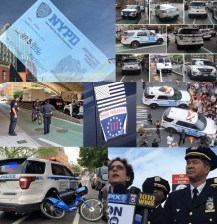If Police Don’t Take Traffic Violence Seriously, Vision Zero Will Fail
Eight months in, Mayor de Blasio and his administration should be proud of how much has been achieved under the Vision Zero program. As an attorney and advocate for crash victims, my expectations were exceeded by the early progress in almost every area of this multi-agency initiative. There have even been noticeable changes at the police department — the one agency that historically has been most resistant to stepping up on street safety. But as shown by the Dulcie Canton scandal NYPD’s response has been inconsistent. [Disclosure: The author is on the board of StreetsPAC, which endorsed Bill de Blasio for mayor, and his law firm represents Dulcie Canton.]
Dulcie’s case illustrates the gaping holes that remain in NYPD’s approach to Vision Zero. She was struck with tremendous force in a horrific hit-and-run crash on August 7 and suffered serious injuries, somehow managing to escape with her life (in large part because she was wearing a helmet). Surveillance video shows a sedan driver speeding behind her fully-illuminated bicycle, striking her, and driving off without so much as hesitating.
Although, as is often the case, the surveillance video did not capture the car’s license plate, and the driver sped off before witnesses could get a look at him, Bushwick residents at the crash scene came together in a remarkable way to help identify the driver. The owner of the building by the crash site went to extraordinary lengths to preserve footage from his surveillance cameras. People on the block recovered a piece of the car that fell off when it struck Dulcie, bearing serial numbers that link it to the vehicle. The skateboarder with Dulcie that night worked with neighbors to identify the car, parked just a block or so from the crash scene. This prompt action from neighborhood residents — the lengths people went to in order to help a crash victim and find a perpetrator — shows just how much the principles of Vision Zero matter to New Yorkers.
All that was left for me to do as Dulcie’s lawyer was to bring this evidence to the police and let them do their job — or so I thought. But that’s where the process broke down. Because Dulcie thankfully hadn’t been killed or critically injured, the NYPD’s Collision Investigation Squad did not respond. Instead, a detective at the 83rd Precinct was assigned to investigate the case as a hit-and-run. With all optimism, I met with the detective on the fourth day after Dulcie’s crash and gave him all the evidence, and told him we were waiting to inform the insurer of the car of our claim because we didn’t want the company to alert the owner of the car to the investigation.
Over the following month, I followed up with the detective several times by phone and in writing. He explained to me that he was busy with a heavy caseload and needed more time before he could question the owner. After three weeks, the Bushwick neighbors who had been so helpful and had continued to monitor the car advised that the owner had fixed the damage from the crash. Now that critical evidence was being lost and concealed, we had to act, and so the car’s insurer was alerted.
Naturally, I heard back from the insurer that the owner of the car denied any knowledge of the incident. But recent press attention to this case has caught the attention of some law enforcement officials, and following a meeting yesterday it appears that Dulcie’s crash may finally be investigated as it should have been. Many thanks to folks who made phone calls and used social media to help us move this case higher on NYPD’s to-do list!
I have no way to assess the detective’s explanation that he was too busy with more serious cases to interview the car owner for more than a month. What I do know is that there must be systems in place to ensure adequate and timely attention to cases like this, or hit-and-runs and other forms of traffic violence will never reach or even approach “zero.”
I have on many occasions encountered deeply held cultural biases among police against investigating traffic crimes. They don’t take them as seriously as other crimes. A “quality of life” crime like selling loosies is enough to trigger a fatal encounter under the broken windows program, but a naked act of aggression with a deadly weapon like the hit-and-run that could have killed Dulcie warrants attention only, as the detective put it to me, if police “have the time.”
Now that Administrative Code 119-90 is law, thousands of cases like Dulcie’s are misdemeanors — crimes — that require law enforcement resources and attention. This applies to crashes involving a failure to yield the right of way, even if the driver is sober and stays at the scene. Yet NYPD shows no sign it is even aware that this law took effect two weeks ago, and continues to let nonfatal traffic violence cases fall through the law enforcement sieve.
If NYPD Commissioner Bill Bratton can “turn the Queen Mary” of police attitudes toward traffic crime, Vision Zero will be his lasting legacy. If he fails, Vision Zero may fail with him. But if he doesn’t even try to address this fundamental problem — and that is looking like a distinct possibility right now — it will be his and Mayor de Blasio’s disgrace.
